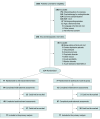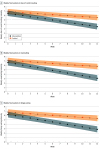Effectiveness of a Web-Based Cognitive Behavioral Self-Help Intervention for Binge Eating Disorder: A Randomized Clinical Trial
- PMID: 38753330
- PMCID: PMC11099688
- DOI: 10.1001/jamanetworkopen.2024.11127
Effectiveness of a Web-Based Cognitive Behavioral Self-Help Intervention for Binge Eating Disorder: A Randomized Clinical Trial
Abstract
Importance: Binge eating disorder (BED) is one of the most frequent eating pathologies and imposes substantial emotional and physical distress, yet insufficient health care resources limit access to specialized treatment. Web-based self-help interventions emerge as a promising solution, offering more accessible care.
Objective: To examine the effectiveness of a web-based cognitive behavioral self-help intervention for individuals with BED.
Design, setting, and participants: This 2-arm, parallel-group randomized clinical trial conducted from January 15, 2021, to August 3, 2022, in Germany and other German-speaking countries enrolled patients aged 18 to 65 years who met the diagnostic criteria for BED (according to the Diagnostic and Statistical Manual of Mental Disorders [Fifth Edition]). Data analysis occurred between January 27 and September 4, 2023, following our statistical analysis plan.
Interventions: Participants were randomized to a web-based self-help intervention or a waiting-list control condition.
Main outcomes and measures: The primary outcome was a change in objective binge eating episodes from baseline to after treatment. Secondary outcomes included global eating pathology, clinical impairment, work capacity, well-being, comorbid psychopathology, self-esteem, and emotion regulation.
Results: A total of 1602 patients were screened, of whom 154 (mean [SD] age, 35.93 [10.59] years; 148 female [96.10%]) fulfilled the criteria for BED and were randomized (77 each to the intervention and control groups). The web-based intervention led to significant improvements in binge eating episodes (Cohen d, -0.79 [95% CI, -1.17 to -0.42]; P < .001), global eating psychopathology (Cohen d, -0.71 [95% CI, -1.07 to -0.35]; P < .001), weekly binge eating (Cohen d, -0.49 [95% CI, -0.74 to -0.24]; P < .001), clinical impairment (Cohen d, -0.75 [95% CI, -1.13 to -0.37]; P < .001), well-being (Cohen d, 0.38 [95% CI, 0.01 to 0.75]; P = .047), depression (Cohen d, -0.49 [95% CI, -0.86 to -0.12]; P = .01), anxiety (Cohen d, -0.37 [95% CI, -0.67 to -0.07]; P = .02), self-esteem (Cohen d, 0.36 [95% CI, 0.13 to 0.59]; P = .003), and emotion regulation (difficulties: Cohen d, -0.36 [95% CI, -0.65 to -0.07]; P = .01 and repertoire: Cohen d, 0.52 [95% CI, 0.19 to 0.84]; P = .003).
Conclusion and relevance: In this randomized clinical trial of a web-based self-help intervention for patients with BED, the findings confirmed its effectiveness in reducing binge eating episodes and improving various mental health outcomes, highlighting a scalable solution to bridge the treatment gap for this condition.
Trial registration: ClinicalTrials.gov Identifier: NCT04876183.
Conflict of interest statement
Figures



Comment in
-
Digital Interventions to Close the Treatment Gap for Binge Eating.JAMA Netw Open. 2024 May 1;7(5):e2411108. doi: 10.1001/jamanetworkopen.2024.11108. JAMA Netw Open. 2024. PMID: 38753334 No abstract available.
Similar articles
-
Web-Based Cognitive Behavioral Treatment for Bulimia Nervosa: A Randomized Clinical Trial.JAMA Netw Open. 2024 Jul 1;7(7):e2419019. doi: 10.1001/jamanetworkopen.2024.19019. JAMA Netw Open. 2024. PMID: 38958978 Free PMC article. Clinical Trial.
-
Web-Based Cognitive Behavioral Therapy for Female Patients With Eating Disorders: Randomized Controlled Trial.J Med Internet Res. 2015 Jun 18;17(6):e152. doi: 10.2196/jmir.3946. J Med Internet Res. 2015. PMID: 26088580 Free PMC article. Clinical Trial.
-
Effectiveness of web-based guided self-help cognitive behavioral therapy-enhanced for binge-eating disorder: An implementation study.Int J Eat Disord. 2024 Jun;57(6):1379-1389. doi: 10.1002/eat.24079. Epub 2023 Oct 25. Int J Eat Disord. 2024. PMID: 37876352
-
The efficacy of internet-based cognitive behavioral therapy for adult binge spectrum eating disorders: A meta-analysis.J Affect Disord. 2024 Sep 15;361:684-692. doi: 10.1016/j.jad.2024.06.084. Epub 2024 Jun 25. J Affect Disord. 2024. PMID: 38936703 Review.
-
Meta-analysis on the long-term effectiveness of psychological and medical treatments for binge-eating disorder.Int J Eat Disord. 2020 Sep;53(9):1353-1376. doi: 10.1002/eat.23297. Epub 2020 Jun 25. Int J Eat Disord. 2020. PMID: 32583527 Review.
Cited by
-
Advancing Mental Health Care: A Comprehensive Review of Digital Tools and Technologies for Enhancing Diagnosis, Treatment, and Wellness.Health Care Sci. 2025 May 31;4(3):163-178. doi: 10.1002/hcs2.70018. eCollection 2025 Jun. Health Care Sci. 2025. PMID: 40568629 Free PMC article. Review.
-
Mental Health Impacts of Self-Help Interventions for the Treatment and Prevention of Eating Disorders. A Meta-Analysis.Int J Eat Disord. 2025 May;58(5):815-831. doi: 10.1002/eat.24405. Epub 2025 Mar 3. Int J Eat Disord. 2025. PMID: 40026263 Free PMC article. Review.
-
A Brief Online Intervention Based on Dialectical Behavior Therapy for a Reduction in Binge-Eating Symptoms and Eating Pathology.Nutrients. 2024 Aug 14;16(16):2696. doi: 10.3390/nu16162696. Nutrients. 2024. PMID: 39203832 Free PMC article.
-
Experts' views on the implementation of digital interventions for eating disorders: a Delphi study.BMC Public Health. 2024 Sep 12;24(1):2486. doi: 10.1186/s12889-024-19989-3. BMC Public Health. 2024. PMID: 39267038 Free PMC article.
-
Web-Based Cognitive Behavioral Treatment for Bulimia Nervosa: A Randomized Clinical Trial.JAMA Netw Open. 2024 Jul 1;7(7):e2419019. doi: 10.1001/jamanetworkopen.2024.19019. JAMA Netw Open. 2024. PMID: 38958978 Free PMC article. Clinical Trial.
References
Publication types
MeSH terms
Associated data
LinkOut - more resources
Full Text Sources
Medical
Miscellaneous

